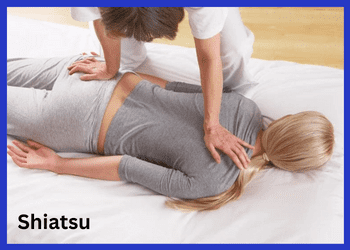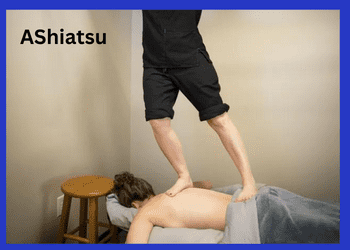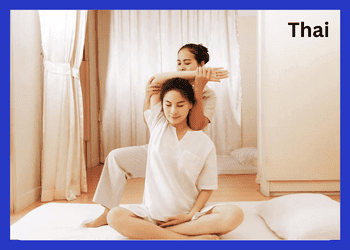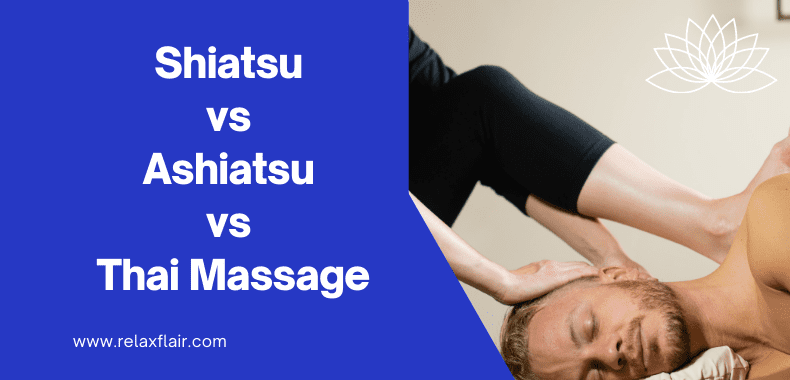Alternative massages have gained popularity in recent years as more people are looking for natural ways to manage stress, pain, and overall well-being. Unlike traditional massages that mainly focus on muscle relaxation, alternative massages such as Shiatsu, Ashiatsu, and Thai massage involve manipulating the body’s energy flow to achieve balance and harmony. In this article, we will compare and contrast the main differences between these three types of alternative massages.
It’s worth noting that many modern massage chairs also offer Shiatsu, Ashiatsu, and Thai massage techniques, providing a convenient and cost-effective way to experience the benefits of these alternative massage techniques from the comfort of your home or office. However, while massage chairs can be a great addition to your self-care routine, they do not replace the human touch and personalized attention that a trained massage therapist can provide.
We will explore the origins, techniques, benefits, and unique features of each massage, as well as answer frequently asked questions to help you choose which one is right for you. Whether you’re a seasoned massage enthusiast or a newcomer to the world of alternative therapies, this guide will provide you with valuable insights and information to help you make an informed decision.
What is Shiatsu Technique?
Shiatsu is a Japanese massage therapy that focuses on applying pressure to specific points in the body to stimulate the flow of energy and promote healing. The word Shiatsu translates to “finger pressure,” but practitioners may also use their palms, elbows, and knees to apply pressure.
 Shiatsu originated in Japan in the early 20th century, but it is based on traditional Chinese medicine principles such as acupuncture and acupressure. Shiatsu aims to balance the body’s energy flow, or qi, by stimulating the body’s meridians or energy channels.
Shiatsu originated in Japan in the early 20th century, but it is based on traditional Chinese medicine principles such as acupuncture and acupressure. Shiatsu aims to balance the body’s energy flow, or qi, by stimulating the body’s meridians or energy channels.
During a Shiatsu massage, the practitioner will use a combination of techniques and movements to apply pressure to specific points on the body. These techniques may include:
- Pressing and holding: The practitioner will apply pressure to a specific point on the body and hold it for a few seconds.
- Kneading: The practitioner will use their fingers or palms to knead the muscles.
- Tapping: The practitioner will use their fingers or palms to tap the body.
- Stretching: The practitioner may use stretching techniques to release tension in the muscles.
Shiatsu focuses on specific pressure points and meridians on the body, including:
- Tsubos: These are the specific pressure points on the body that Shiatsu practitioners use to stimulate the flow of energy.
- Meridians: These are the energy channels on the body that are connected to specific organs and body functions.
The benefits of Shiatsu massage are numerous and may include:
- Pain relief: Shiatsu can help relieve tension headaches, back pain, and neck pain.
- Stress reduction: Shiatsu can promote relaxation and reduce stress levels.
- Improved circulation: Shiatsu can improve blood flow and oxygenation to the body’s tissues.
- Increased flexibility: Shiatsu can help increase the range of motion and flexibility.
- Boosted immune system: Shiatsu can stimulate the body’s immune system, promoting overall health and wellness.
The drawbacks:
- Some people may find the pressure to be too intense or uncomfortable
- It may not be suitable for people with certain medical conditions or injuries, such as osteoporosis or fractures
- It may not be as effective for people who prefer a more gentle touch or lighter pressure in their massage
- It may not address specific areas of pain or tension as effectively as other massage techniques
Shiatsu massage chairs are designed to replicate the pressure and techniques used in traditional Shiatsu massage. The chairs use rollers, airbags, and other mechanisms to apply pressure to specific points on the body, simulating the pressure applied by a Shiatsu practitioner’s hands and fingers. The chairs may also include heating elements to further enhance the experience.
What is AShiatsu Massage?
Ashiatsu massage is a form of barefoot massage that originated in Asia and has gained popularity in the Western world in recent years. The word Ashiatsu comes from the Japanese words “ashi” meaning foot, and “atsu” meaning pressure.
 During an Ashiatsu massage, the practitioner will use their feet to apply pressure to specific points on the client’s body. The practitioner may hold onto overhead bars or ropes for support while using their feet to deliver deep pressure.
During an Ashiatsu massage, the practitioner will use their feet to apply pressure to specific points on the client’s body. The practitioner may hold onto overhead bars or ropes for support while using their feet to deliver deep pressure.
The pressure points and meridians used in Ashiatsu are similar to those in Shiatsu, as Ashiatsu is also based on traditional Chinese medicine principles. The practitioner will focus on specific points in the body to promote the flow of energy and stimulate healing.
Some of the techniques and movements used in Ashiatsu include:
- Broad compression strokes: The practitioner will use their feet to apply broad, sweeping strokes to the muscles.
- Deep compression strokes: The practitioner will use their feet to apply deep pressure to specific points on the body.
- Gliding strokes: The practitioner will use their feet to glide along the muscles.
- Trigger point work: The practitioner will use their feet to target specific trigger points on the body.
The benefits of Ashiatsu massage may include:
- Deep relaxation: The deep pressure applied during an Ashiatsu massage can promote deep relaxation and relieve tension in the body.
- Improved posture: Ashiatsu can help improve posture by releasing tension in the muscles and aligning the spine.
- Pain relief: Ashiatsu can help relieve chronic pain and tension, including back pain, neck pain, and headaches.
- Improved circulation: Ashiatsu can promote improved circulation and oxygenation of the body’s tissues.
- Increased range of motion: Ashiatsu can help increase flexibility and range of motion in the joints.
The drawbacks:
- It may not be suitable for people who are uncomfortable with the idea of a therapist using their feet to massage them
- The pressure may be too intense for some people, particularly if the therapist is not properly trained or experienced in delivering Ashiatsu massage
- It may not be as effective for people with certain medical conditions or injuries, such as plantar fasciitis or foot injuries
- It may not address specific areas of pain or tension as effectively as other massage techniques
Ashiatsu massage chairs typically use a combination of rollers and airbags to apply pressure to the back, legs, and feet. The chairs may also include special foot rollers to replicate the pressure applied by the Ashiatsu practitioner’s feet. Some Ashiatsu massage chairs may also include heating elements to enhance the massage experience.
What is Thai Massage?
A Thai massage is a form of bodywork that originated in Thailand over 2,500 years ago. It is based on traditional Thai medicine, which combines aspects of Indian Ayurvedic medicine, Chinese medicine, and yoga.
 During a Thai massage, the practitioner will use their hands, knees, legs, and feet to apply pressure to specific points on the client’s body. The practitioner may also use stretching and range-of-motion techniques to help the client release tension and improve flexibility.
During a Thai massage, the practitioner will use their hands, knees, legs, and feet to apply pressure to specific points on the client’s body. The practitioner may also use stretching and range-of-motion techniques to help the client release tension and improve flexibility.
The pressure points and meridians used in Thai massage are based on traditional Chinese medicine principles. The practitioner will focus on specific points in the body to promote the flow of energy and stimulate healing.
Some of the techniques and movements used in Thai massage include:
- Compression: The practitioner will use their hands, feet, elbows, and knees to apply pressure to specific points on the body.
- Stretching: The practitioner will use stretching and range-of-motion techniques to help the client release tension and improve flexibility.
- Joint mobilization: The practitioner will use gentle movements to help the client loosen up their joints.
- Acupressure: The practitioner will apply pressure to specific acupressure points on the body to promote healing and balance.
The benefits of Thai massage may include:
- Stress relief: Thai massage can help reduce stress and promote relaxation.
- Pain relief: Thai massage can help relieve chronic pain and tension, including back pain, neck pain, and headaches.
- Improved circulation: Thai massage can promote improved circulation and oxygenation of the body’s tissues.
- Increased range of motion: Thai massage can help increase flexibility and range of motion in the joints.
- Improved immune system function: Thai massage can stimulate the body’s natural healing mechanisms and improve immune system function.
Thai massage chairs offer a unique way to replicate the classic techniques of traditional Thai massage. Rollers, airbags, and stretching mechanisms are all included in addition to specialized padding for comfort and superior support, allowing practitioners to manipulate the client’s body with ease; just as if they were engaging in an authentic Thai massage session.
The drawbacks:
- It may not be suitable for people who prefer a more relaxing, gentle massage experience
- Some people may find the stretches to be too intense or uncomfortable
- It may not be suitable for people with certain medical conditions or injuries, such as herniated discs or joint problems
- It may not address specific areas of pain or tension as effectively as other massage techniques
Not only do some Thai massage chairs come with heating elements and aromatherapy components to improve your experience, but it’s important to remember that they cannot replicate a traditional Thai massage. This is because the practitioner relies on their full body weight and various movements while providing the massage – something which a chair simply cannot recreate.
Shiatsu vs Ashiatsu vs Thai Massage: Differences and Similarities
| Massage Type | Technique | Pressure Points/Meridians | Practitioner Use | Massage Chair Replication |
|---|---|---|---|---|
| Shiatsu | Uses finger pressure and kneading techniques to stimulate pressure points along the body’s meridians. | Focuses on specific pressure points and meridians to promote the flow of energy and healing. | The practitioner uses hands and fingers to apply pressure to the client’s body. | Shiatsu massage chairs use rollers and airbags to apply pressure to specific points on the body. Some chairs may also include heating elements. |
| Ashiatsu | The practitioner uses their feet to apply deep, broad pressure along the client’s back and legs. | Focuses on the same pressure points and meridians as Shiatsu massage. | The practitioner uses their feet and body weight to apply pressure to the client’s body. | Ashiatsu massage chairs use rollers and airbags to apply pressure to the back, legs, and feet. Some chairs may also include heating elements and specialized foot rollers. |
| Thai Massage | Uses a combination of stretching, acupressure, and joint mobilization techniques to improve energy flow and flexibility. | Focuses on specific acupressure points and meridians to promote healing and balance. | The practitioner uses their hands, feet, elbows, and knees to apply pressure and stretch the client’s body. | Thai massage chairs use rollers, airbags, and stretching mechanisms to replicate the techniques used in traditional Thai massage. Some chairs may also include heating elements and aromatherapy features. However, it is important to note that a traditional Thai massage cannot be fully replicated by a chair, as the practitioner uses their full body weight and various movements to provide the massage. |
While each of these massage types has its own unique technique and approach, they all share some similarities in terms of their focus on specific pressure points and meridians. Additionally, all three types can be replicated to some extent by massage chairs, although the experience may not be exactly the same as a traditional massage from a trained practitioner.
FAQs
Can Thai Massage Help with Specific Health Conditions?
Uncover the incredible powers of Thai massage! Studies have revealed that this ancient practice can be used to treat a multitude of health conditions, including but not limited to: increased flexibility, alleviated stress and pain levels, improved circulation and breathing patterns, and decreased depression symptoms such as anxiety or insomnia. Plus experience notable relief from headaches and aches in your musculoskeletal system when you receive a Thai massage. However, it is crucial to bear in mind that Thai massage should not be used as a replacement for medical treatment. People with specific health conditions are highly recommended to consult their healthcare provider before getting a Thai massage.
How Often Should I Get Thai Massage?
The frequency of Thai massage sessions depends on an individual’s health and wellness goals. For individuals seeking relaxation and stress relief, one Thai massage session per month may be sufficient. However, for those seeking relief from chronic pain or specific health conditions, more frequent sessions may be necessary. It is recommended to consult with a licensed massage therapist to determine the appropriate frequency and duration of Thai massage sessions based on individual needs.
Are alternative Massages Covered by Insurance?
Coverage for alternative massages such as Shiatsu, Ashiatsu, and Thai massage varies depending on the insurance provider and plan. Some insurance plans may offer coverage for alternative therapies as part of their wellness or alternative medicine benefits. However, many insurance plans do not cover alternative massages. It is important to check with your insurance provider to determine if alternative massages are covered under your plan.
Can I Get a Combination of Different Massages During One Session?
Yes, it is possible to receive a combination of different massages during one session. Many massage therapists are trained in multiple massage techniques and can tailor the session to meet the individual needs of their clients. For example, a massage therapist may incorporate Shiatsu or Ashiatsu techniques into a Thai massage session to provide a more comprehensive and personalized massage experience. It is recommended to discuss the desired massage techniques with the therapist prior to the session to ensure that the session meets individual preferences and needs.
When Should You Not Do Shiatsu Massage?
Shiatsu massage, rooted in traditional Japanese healing practices, is widely appreciated for its therapeutic benefits. However, there are certain situations and health conditions where Shiatsu massage should be avoided to prevent potential harm. Here’s a detailed examination of when you should not engage in Shiatsu massage.
Contraindications for Shiatsu Massage
1. Acute Injuries
Avoid Shiatsu massage if you have acute injuries such as sprains, fractures, or recent surgeries. The pressure applied during the massage could exacerbate pain, increase inflammation, or interfere with the healing process. It’s crucial to allow adequate time for these injuries to heal before considering Shiatsu.
2. Inflammatory Conditions
Inflammatory conditions, such as rheumatoid arthritis or severe dermatitis, can be aggravated by the pressure and manipulation involved in Shiatsu. Massaging inflamed areas may lead to increased pain and swelling. It’s best to wait until the inflammation has subsided or consult a healthcare professional for alternative treatments.
3. Infectious Diseases
Shiatsu massage should be avoided if you are suffering from an infectious disease, including skin infections, contagious illnesses, or systemic infections like the flu. The physical contact and pressure could spread the infection or worsen your symptoms.
4. Cardiovascular Issues
Individuals with severe cardiovascular issues, such as uncontrolled hypertension, deep vein thrombosis (DVT), or severe varicose veins, should avoid Shiatsu massage. The pressure applied during the massage can affect blood circulation and potentially lead to complications like clot dislodgement or increased blood pressure.
5. Cancer
If you are undergoing cancer treatment or have a history of cancer, it is essential to consult your oncologist before receiving Shiatsu massage. Certain types of massage can stimulate blood flow and lymphatic circulation, which may be contraindicated depending on the type and stage of cancer and treatment status.
6. Pregnancy
During pregnancy, especially in the first trimester, it’s crucial to avoid Shiatsu massage unless performed by a therapist specifically trained in prenatal massage. Certain pressure points in the body are believed to stimulate uterine contractions, posing a risk of miscarriage or preterm labor.
7. Fever
If you have a fever, it is advisable to avoid Shiatsu massage. Fever indicates an active infection or inflammation in the body, and massage can potentially spread the infection or worsen the inflammation.
Special Considerations
1. Chronic Conditions
For those with chronic conditions such as diabetes or osteoporosis, a modified approach to Shiatsu may be necessary. Consult with a healthcare provider and ensure that the therapist is aware of your condition to adapt the massage technique accordingly.
2. Medications
Certain medications, particularly blood thinners, may increase the risk of bruising or bleeding during a Shiatsu massage. Always inform your therapist about any medications you are taking.
While Shiatsu massage offers numerous benefits, it is not suitable for everyone. Acute injuries, inflammatory conditions, infectious diseases, cardiovascular issues, cancer, pregnancy, and fever are key contraindications. Always consult with a healthcare professional before beginning any new massage therapy, especially if you have underlying health conditions or are on medication. Prioritizing safety ensures that you can enjoy the therapeutic benefits of Shiatsu massage without adverse effects.
Conclusion
While each technique has its own strengths and potential drawbacks, they all share a focus on pressure points, meridians, and energy flow in the body. Additionally, massage chairs have become increasingly advanced in recent years, offering the ability to mimic some of the techniques used in these massages.
Whether you’re looking to relieve stress, ease muscle tension, or improve overall wellbeing, exploring these different massage techniques can provide a range of benefits for the mind and body. It’s important to consult with a qualified massage therapist and consider your individual needs and preferences before deciding which technique is right for you.
